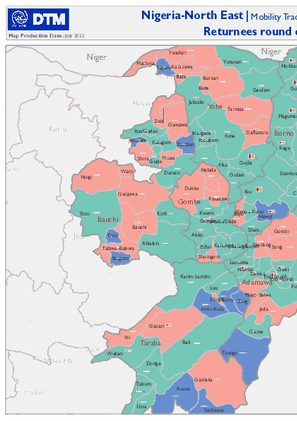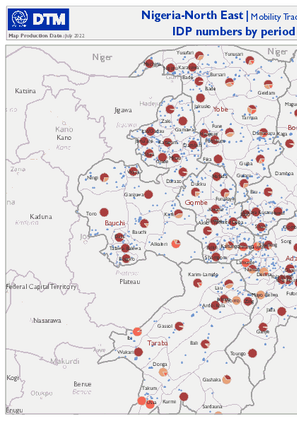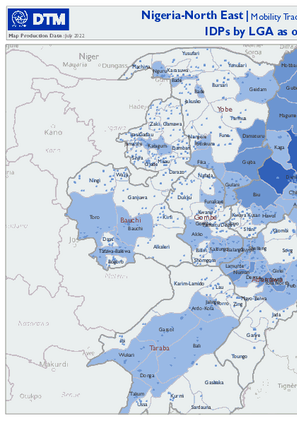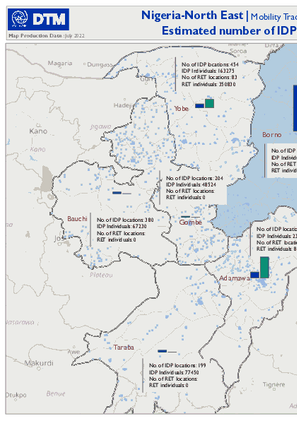-
Countries
-
Data and Analysis
-
Special Focus
-
Crisis Responses
Returnees round comparison at LGA
IDPs by Reason of Displacement
IDP numbers by period of arrival
IDPs by LGA
Estimated number of IDPs and Returnees by LGA
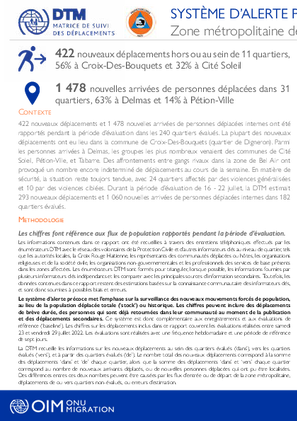
Contact
dtmhaiti@iom.int
Language
English
Location
Haiti
Period Covered
Jul 23 2022
Jul 29 2022
Activity
- Event Tracking
422 nouveaux déplacements et 1 478 nouvelles arrivées de personnes déplacées internes ont été rapportés pendant la période d’évaluation dans les 240 quartiers évalués. La plupart des nouveuax déplacements ont eu lieu dans la commune de Croix-Des-Bouquets (quartier de Digneron). Parmi les personnes arrivées à Delmas, les groupes les plus nombreux venaient des communes de Cité Soleil, Pétion-Ville, et Tabarre. Des affrontements entre gangs rivaux dans la zone de Bel Air ont provoqué un nombre encore indeterminé de déplacements au cours de la semaine. En matière de sécurité, la situation reste toujors tendue, avec 24 quartiers affectés par des violences généralisées et 10 par des violences ciblées. Durant la période d’évaluation de 16 - 22 juillet, la DTM estimait 293 nouveaux déplacements et 1 060 nouvelles arrivées de personnes déplacées internes dans 182 quartiers évalués.
Contact
DTM Yemen, iomyemendtm@iom.int
Location
Yemen
Activity
- Mobility Tracking
- Event Tracking
Period Covered
Jul 17 2022 -Jul 23 2022
From 1 January to 23 July 2022, IOM Yemen DTM tracked 7,348 households (HH) (44,088 Individuals) who experienced displacement at least once.
Between 17 and 23 July 2022, IOM Yemen DTM tracked 169 households (1,014 individuals) displaced at least once. The majority of people moved into/within the following governorates and districts:
- Marib (87 HHs) – Harib (67 HHs), Marib City (13 HHs), Marib (7 HHs) districts. Most displacements in the governorate originated from Marib and Ibb.
- Al Jawf (51 HHs) – Khab wa Ash Shaf (51 HHs) district. All displacements in the governorate were internal.
- Ad Dali (15 HHs) – Qatabah (9 HHs), Ad Dali (6 HHs) districts. Most displacements in the governorate originated from Ad Dali and Ibb.
- Marib (68 HHs) – Harib (64 HHs), Sirwah (3 HHs), Raghwan (1 HHs) districts.
- Al Jawf (51 HHs) – Khab wa Ash Shaf (51 HHs) district.
- Al Hodeidah (23 HHs) – Hays (10 HHs), At Tuhayta (2 HHs), Al Jarrahi (2 HHs) districts.
Population Groups
Survey Methodology
Unit of Analysis Or Observation
Type of Survey or Assessment
Keywords
Geographical Scope
Administrative boundaries with available data
The current dataset covers the following administrative boundaries
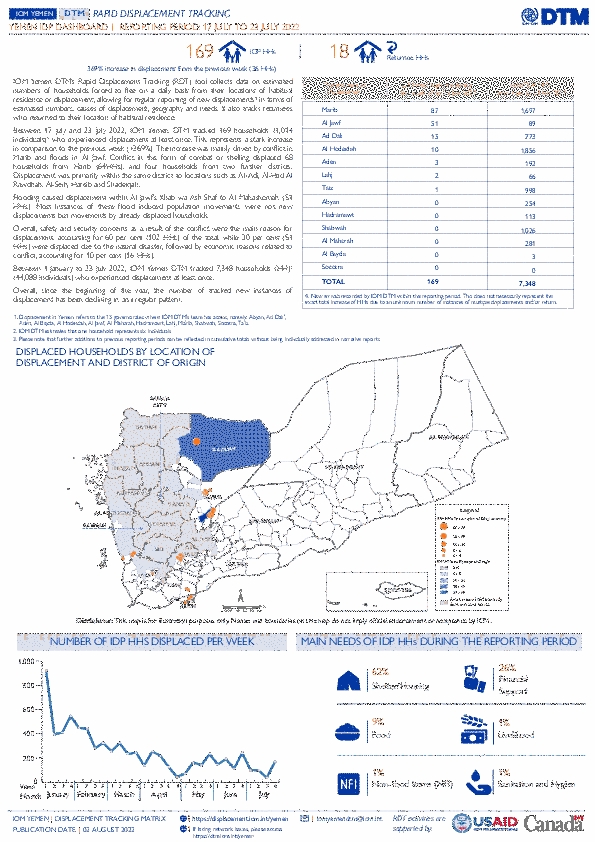
Contact
DTM Yemen, iomyemendtm@iom.int
Language
English
Location
Yemen
Period Covered
Jul 17 2022
Jul 23 2022
Activity
- Mobility Tracking
From 1 January to 23 July 2022, IOM Yemen DTM tracked 7,348 households (HH) (44,088 Individuals) who experienced displacement at least once.
Between 17 and 23 July 2022, IOM Yemen DTM tracked 169 households (1,014 individuals) displaced at least once. The majority of people moved into/within the following governorates and districts:
- Marib (87 HHs) – Harib (67 HHs), Marib City (13 HHs), Marib (7 HHs) districts. Most displacements in the governorate originated from Marib and Ibb.
- Al Jawf (51 HHs) – Khab wa Ash Shaf (51 HHs) district. All displacements in the governorate were internal.
- Ad Dali (15 HHs) – Qatabah (9 HHs), Ad Dali (6 HHs) districts. Most displacements in the governorate originated from Ad Dali and Ibb.
The majority of people moved from the following governorates and districts:
- Marib (68 HHs) – Harib (64 HHs), Sirwah (3 HHs), Raghwan (1 HHs) districts.
- Al Jawf (51 HHs) – Khab wa Ash Shaf (51 HHs) district.
- Al Hodeidah (23 HHs) – Hays (10 HHs), At Tuhayta (2 HHs), Al Jarrahi (2 HHs) districts.
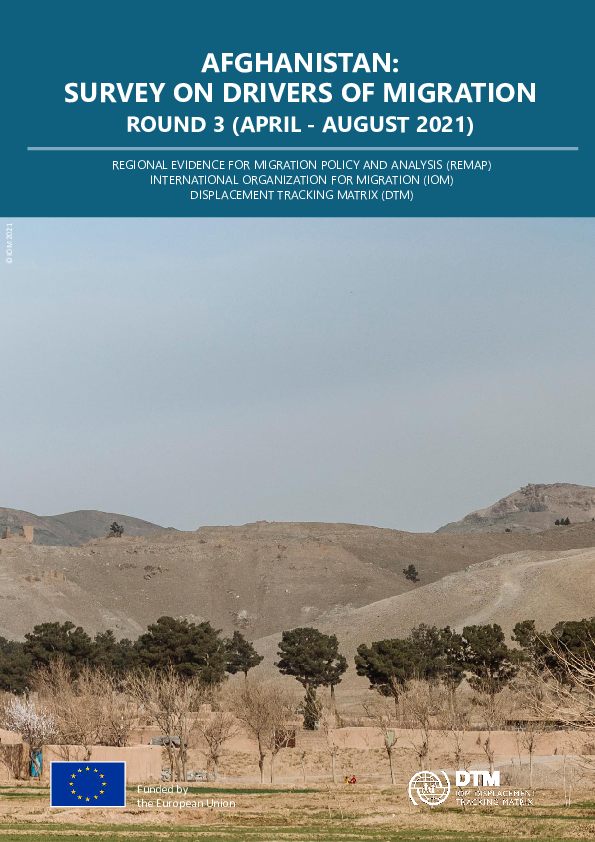
Contact
dtmremapsupport@iom.int
Language
English
Location
Afghanistan
Period Covered
Apr 01 2021
Aug 31 2021
Activity
- Survey
- Flow Monitoring Survey
- Return Intention
This report demonstrates how Afghan mobility is the result of a range of factors related to economic conditions and prolonged conflict within the country. Between April 2021 and August 2021 (Round 3 of SDM), various provinces of Afghanistan were affected by active conflict, which was followed by the fall of the government in Afghanistan on 15 August 2021. This resulted in civilian casualties, the loss of livelihoods, internal displacement, and cross-border mobility. Therefore, the decisions to leave Afghanistan and choose a destination country revolved around multiple intersections of these factors as opposed to an identifiable, single reason.
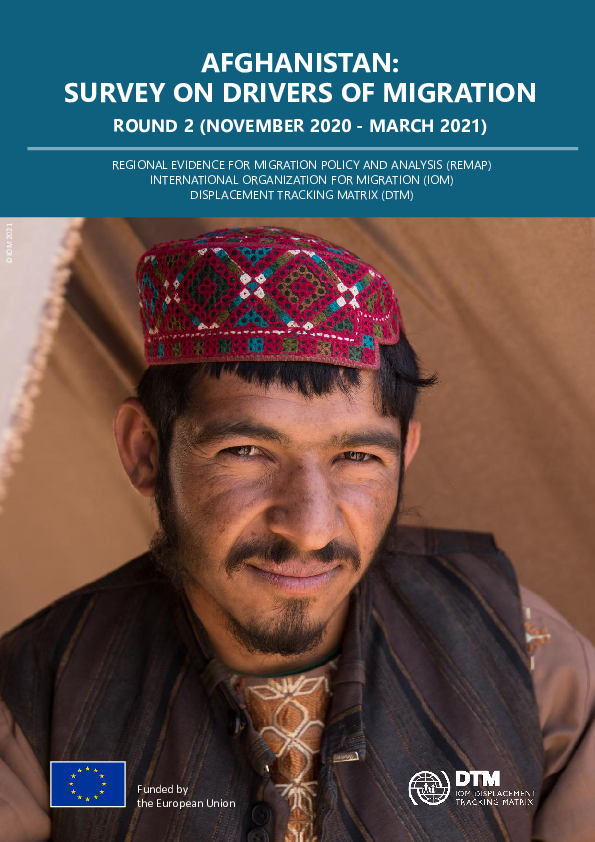
Contact
dtmremapsupport@iom.int
Language
English
Location
Afghanistan
Period Covered
Nov 01 2020
Mar 31 2021
Activity
- Survey
- Flow Monitoring Survey
- Return Intention
This report will demonstrate how Afghan mobility is the result of a range of factors related to economic conditions and prolonged conflict within the country. Most importantly, these factors are mutually reinforcing, exacerbating one another and emphasizing the multifaceted nature of migration out of Afghanistan. During the reporting period, between November 2020 and March 2021 (Round 2), the decisions to leave Afghanistan and to choose a destination country revolved primarily around the intersection of economic conditions and conflict within the country. Those leaving Afghanistan, therefore, were motivated by the multiple intersections of these factors as opposed to an identifiable single reason.
